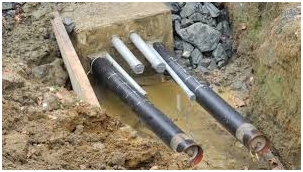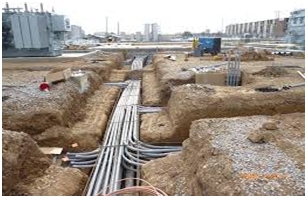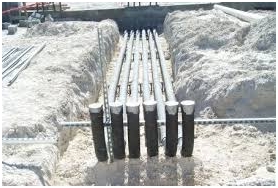When we check our boxmail to see if some of you sent us articles to publish in the blog, we notice that “substation” is a topic that you all often choose to deal with.
Even though we already published articles about this topic, we want you to check another one by Eric, one of our readers. He tells us what a substation design engineer should know…Will you agree?
In power substations, conduits are used in several locations and in several ways. A substation design engineer decides on how, where, what size and what quality conduits are to be used in a power substations depending on its location, substation capacity and other parameters that persist with each substation.
While a substation design engineer decides on the external conduits of a power substation for the backyard equipment, an electrician or the manufacturer of the electrical equipment decides on the conduits to be used in the enclosure of the substation.
Being a substation design engineer, one should know a few things about the conduits, their types, sizes and their placement to effectively design and implement conduit installation in power stations.
What a substation design engineer should know about conduits?
Before we discuss further on conduit types and installation, let us first understand what a conduit is. A conduit is a pathway also known as a raceway, which houses the cables that are connected to the substation equipment residing outside in the backyard, such as transformers, circuit breakers, instrument transformers, disconnecting switches, etc.
Types of Conduits
There are several types of conduits, each made of a different material. A substation design engineer chooses which ones to use for a particular substation.
In order to have an in-depth understanding of the various types of approved conduits, please refer to NEC articles 342 -362.
In general, conduits are generally classified into metallic and non-metallic types.
- Most conduits that run under the ground (below-grade conduits) are of the PVC type. The reason being, PVC conduits are non-corrosive and can be buried directly in the ground with ease. Alternatively, they can also be laid on ground and then encased in concrete.
- PVC conduits can also be used for above grade conditions, but the only catch here is that the substation should be located in warm conditions. It should also be seen that the conditions near the power station are very protective, i.e., there should be no threat of physical damage to the conduits.
- PVC conduits do not suit frost or cold climatic conditions. In such conditions, they can get brittle and eventually break. Hence, substation design engineers generally do not suggest these conduits for above grade usage in the power substations that are located in extremely cold climatic conditions.
- Alternatively, in cold climatic conditions, PVC can be used for underground cabling, but at the point where cables pop up of the ground to be connected to the yard equipment, a conduit transition can be made.
- At the points where the cables are to be exposed from the ground, the PVC conduits are to be replaced by RMC (rigid metallic conduits) that are made of galvanized steel.
- A substation design engineer should carefully study the climatic conditions pertaining at a particular place and before deciding on which conduit is to be used.
For example, at places where the frost depths reach up to four feet or more, heaving comes into the picture. This heaving may cause the conduits to push or pull the cables connected to the equipment. In such cases, substation design engineer should contact the local authorities to estimate the depth of frost that may occur during extreme frosty conditions, and choose the conduits accordingly.
- Also, depending on these estimations, a substation design engineer should be able to decide the burial depth of the conduits to minimize heaving.
- To minimize heaving in such conditions, a substation design engineer may consider the following alternatives:
- Use flexible conduits
- Integrate expansion fittings into the design
- Follow site grading
- Adopt local corrections pertaining to the foundation (i.e., forming a deep sand layer in the burials)
Factors Governing Conduit Design
- Burial Depth: It depends on the governing temperatures, current carrying capacity of the cables, cable ampacity and bending radius. Generally, 18 inches is the recommended burial depth for PVC conduits under normal conditions.
- Bending Radius: It depends on the requirements of a substation. Typical bending angles in a conduit design for a substation can range from 30 to 45 degrees. One should bear in mind that no conduit should run longer than 100 ft or 30 meters and should not have more than two bends of 90 degrees and that too, if unavoidable.
- Conduit Fill: Conduit fill percentage (no. of cables that can be housed in each conduit) generally depends on the diameter of the conduit. But according to the standard conditions, if two or more cables are run through a conduit, then the fill percentage is said to be 40%. This is the case with most power substations as the conduits are filled with at least two conductors. A maximum of four conduits can be used in a single conduit of 6 inches diameter.
- Cable Ampacity De-Rating: It depends on the ambient temperature and the number of cables in the raceway (conduit). According to standards, if the number of cables running through the race way is more than three, their ampacities are to be reduced or de-rated by appropriate percentage.
To comply with these rules, you might want to reduce the size of the conductors in the race way. Ampacity rating keeps varying for each substation depending on the conduit fill and burial depth.
Conclusion
Above mentioned are a few of the most important factors that a substation design engineer should consider carefully before planning and installing the conduits for a power substation.
For additional information on conduit selection and installation you can refer to, “Applying the National Electrical Code to Substations – Jeff Heinemann, Mark Scheid.”
Let me know what you think about this article,
Eric.



a substation engineer shall know it’s quite important to have qualified post insulator to bear the bending strengh when the circut breaker is switched on. To have those test needs a insulator testing machines, see page:
http://www.contune-intl.com/products/testing-machine/